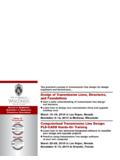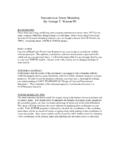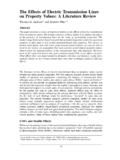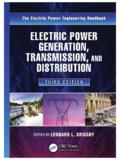Transcription of Types of Transmission Structures - Chino Hills
1 Fact Fact Sheet Sheet Types of Transmission Structures Transmission Structures are one of the most visible elements of the electric Transmission system. They support the conductors used to transport electric power from generation sources to cus- tomer load. Transmission lines carry electricity over long distances at high voltages, typically between 115 kV and 765 kV. (115,000 volts and 765,000 volts). The conductors (wires) are usually attached to large Structures . There are many different designs for Transmission Structures . Two common Types are: Lattice Steel Towers (LST) consist of a steel Tubular Steel Poles (TSP) are hollow steel poles framework comprised many structural compo- fabricated either as one piece or as several pieces nents that are bolted or welded together.
2 Fitted together. 500-kV single-circuit LST 500-kV double-circuit LST 500-kV single-circuit TSP 500-kV double-circuit TSP. Both LSTs and TSPs can be designed to carry either one or two electrical circuits, referred to as single- circuit and double-circuit Structures (see examples above). Double-circuit Structures typically hold the con- ductors in a vertical or stacked configuration, whereas single-circuit Structures typically hold the conductors horizontally. Due to the vertical configuration of the conductors, double-circuit Structures are taller than single- circuit Structures . On lower voltage lines, Structures sometimes carry more than two circuits. A single-circuit AC Transmission line has three phases. At low voltages, a phase usually consists of one con- ductor.
3 At high voltages (over 200 kV), a phase can consist of multiple conductors (bundled) separated by short spacers. A double-circuit AC Transmission line has two sets of three phases. A high-voltage DC Transmission line (HVDC) has two poles one for positive and the other for nega- tive current, although sometimes HVDC lines have just one conductor. HVDC Transmission is not com- monly used because transformers cannot change the voltage of DC current. Ground Wires Where a Transmission line turns or ends, a stronger dead-end structure must be used (see photo be- low). A dead-end tower differs from a suspension tower in that it is built to be stronger, often has a wider base, and has stronger insulator strings. Bundled Dead-end towers are used where a Transmission Conductors line ends; where the line turns at a large angle; on (Phases).
4 Each side of a major crossing such as a large river, highway, or large valley; or at intervals to divide the line into segments. Overhead ground wires are attached to the tops of high-voltage Transmission Structures to shield the high-voltage conductors from lightning strikes Single-circuit LST illustrating three phases supported by insulators. Note and increase the reliability of the Transmission line. the two ground wires located at the top of the structure on raised peaks For voltages over 200 kV, two ground wires are often referred to as goat ears.. usually used. Often one of the ground wires will have optic fibers integrated into it to provide com- munications for the operation of the Transmission line. structure sizes vary depending on voltage, topography, and tower type.
5 For example, double-circuit 500-kV LSTs generally range from 150 to 200 feet tall, and single-circuit 500-kV towers generally range from 85 to 190 feet tall. Double-circuit towers are taller than single-circuit towers because the phases are arranged vertically and the lowest phase must maintain a minimum ground clearance, while the phases are arranged horizontally on single-circuit LSTs. As voltage increases, the phases must be sepa- rated by more distance to prevent any chance of interfer- ence or arcing. Thus, higher voltage towers and poles have wider horizontal cross arms than lower volt- age Structures . Dead-end towers at a turn in the line. Note the relative sizes of the single-circuit (left) and double-circuit (right) towers. 220-kV single-circuit LST 220-kV double-circuit LST 500-kV single-circuit LST 500-kV double-circuit LST.





